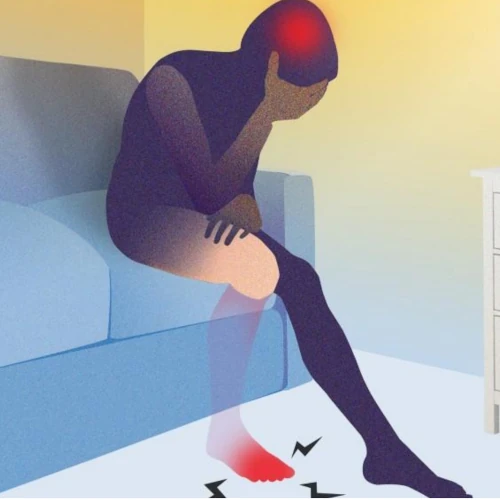
Phantom limb pain affects people who have lost a limb due to injury, surgery, or a birth defect. This pain is real, not imagined, and occurs because the brain and nervous system still register signals from the missing limb. If you or a loved one is struggling with phantom limb pain, understanding the causes and treatment options can help you find relief.
What Causes Phantom Limb Pain?
Phantom limb pain occurs because the brain continues to receive nerve signals from the missing limb. These signals arise due to changes in the nervous system, including:
- Neuropathic Changes: After an amputation, severed nerves continue to send signals, even though the limb is gone. This can result in abnormal pain responses as the nervous system struggles to adapt. The nerve endings at the amputation site may form neuromas, which are clusters of nerve tissue that can generate spontaneous pain signals. Additionally, the brain’s sensory map retains the memory of the missing limb, contributing to persistent pain perception. This miscommunication between the nerves and the brain is a key driver of phantom pain.
- Brain Plasticity: After an amputation, the brain does not simply stop expecting signals from the missing limb. Instead, it adapts by reorganizing sensory and motor pathways. This process, known as cortical remapping, can sometimes lead to misinterpretation of nerve signals, resulting in pain. When the brain’s map of the body is altered, it may incorrectly register pain in the missing limb, even though the limb is no longer there. This maladaptive reorganization plays a key role in the persistence of phantom limb pain.
- Sympathetic Nervous System Activation: The autonomic nervous system, which controls involuntary functions like blood pressure and sweating, can contribute to phantom limb pain by increasing nerve sensitivity. When the body experiences an amputation, the sympathetic nervous system may become hyperactive, leading to an exaggerated pain response. This hypersensitivity can cause nerve fibers in the residual limb to misfire, sending persistent pain signals to the brain. Additionally, changes in blood flow and inflammatory responses regulated by the sympathetic nervous system can further exacerbate pain perception. This is why treatments targeting the sympathetic nervous system, such as nerve blocks, are often effective in reducing phantom pain.
- Scar Tissue and Residual Limb Pain: The healing process after an amputation often leads to the formation of scar tissue. While this tissue is a normal part of recovery, it can sometimes entrap or irritate nearby nerve endings, leading to chronic pain. Additionally, residual limb pain, which occurs at the site of the amputation, may influence phantom limb pain by triggering nerve signals that the brain misinterprets as originating from the missing limb. Poorly fitting prosthetics, excessive pressure on the residual limb, and underlying inflammation can further exacerbate pain, making it essential to address both physical and neurological factors in treatment.

Conservative Treatment Options
Before considering interventional treatments, many patients find relief through conservative approaches that help retrain the nervous system and manage pain. These treatments aim to reduce nerve hypersensitivity and improve overall function without the need for invasive procedures.
- Medications: Neuropathic pain medications like gabapentin or duloxetine can help regulate nerve signaling.
- Mirror Therapy: Using a mirror to reflect the intact limb can help retrain the brain and reduce pain.
- Physical Therapy: Desensitization techniques and graded motor imagery can help improve pain control.
- Psychological Support: Cognitive behavioral therapy (CBT) and relaxation techniques can assist in pain management.
Advanced Options for Phantom Limb Pain
At Red Butte Pain Solutions, we offer several advanced treatment options for phantom limb pain. Our goal is to reduce nerve hypersensitivity and retrain the nervous system to minimize pain perception.
Sympathetic Nerve Blocks for Phantom Limb Pain
One effective way to manage phantom limb pain is through sympathetic nerve blocks. These injections target the sympathetic nervous system to reduce pain and improve circulation.
Stellate Ganglion Blocks
For patients experiencing phantom limb pain in the upper limb, a stellate ganglion block can help. This procedure involves injecting local anesthetic into the stellate ganglion, a cluster of nerves in the neck that influence pain in the arms and hands. We perform this procedure using ultrasound guidance for precision and safety.
Lumbar Sympathetic Blocks
For lower limb phantom pain, we use lumbar sympathetic blocks. This injection targets the sympathetic nerves in the lower back to disrupt pain signals. Like stellate ganglion blocks, this procedure is performed under ultrasound guidance to ensure accurate placement.
Spinal Cord Stimulation for Phantom Limb Pain
If nerve blocks do not provide long-term relief, spinal cord stimulation (SCS) is another option. Spinal cord stimulators use electrical impulses to disrupt pain signals before they reach the brain. This therapy has been effective for many patients with phantom limb pain by reducing the brain’s perception of pain in the missing limb.
How Spinal Cord Stimulation Works:
- A small device is implanted near the spine.
- Electrical impulses are sent to the spinal cord, modulating pain signals.
- Patients can control stimulation levels to achieve optimal pain relief.
Spinal cord stimulation is a promising long-term solution, especially for individuals who do not respond well to medications or nerve blocks. Studies show that spinal cord stimulation can reduce phantom pain by up to 50% in many patients. Research also suggests that approximately 60-70% of individuals who undergo spinal cord stimulation experience significant pain relief, improved function, and a reduced need for pain medications.
Find Relief from Phantom Limb Pain
If you are struggling with phantom pain, Red Butte Pain Solutions offers advanced treatment options tailored to your needs. Whether through sympathetic nerve blocks, spinal cord stimulation, or a combination of therapies, we can help you regain control over your pain.
Schedule a Consultation
Phantom limb pain can worsen over time if left untreated. Seeking treatment early can improve your quality of life and prevent long-term discomfort. Don’t wait—contact us today to explore your options and take control of your pain. Contact Red Butte Pain Solutions today at 602-633-4334 or schedule an appointment online.
